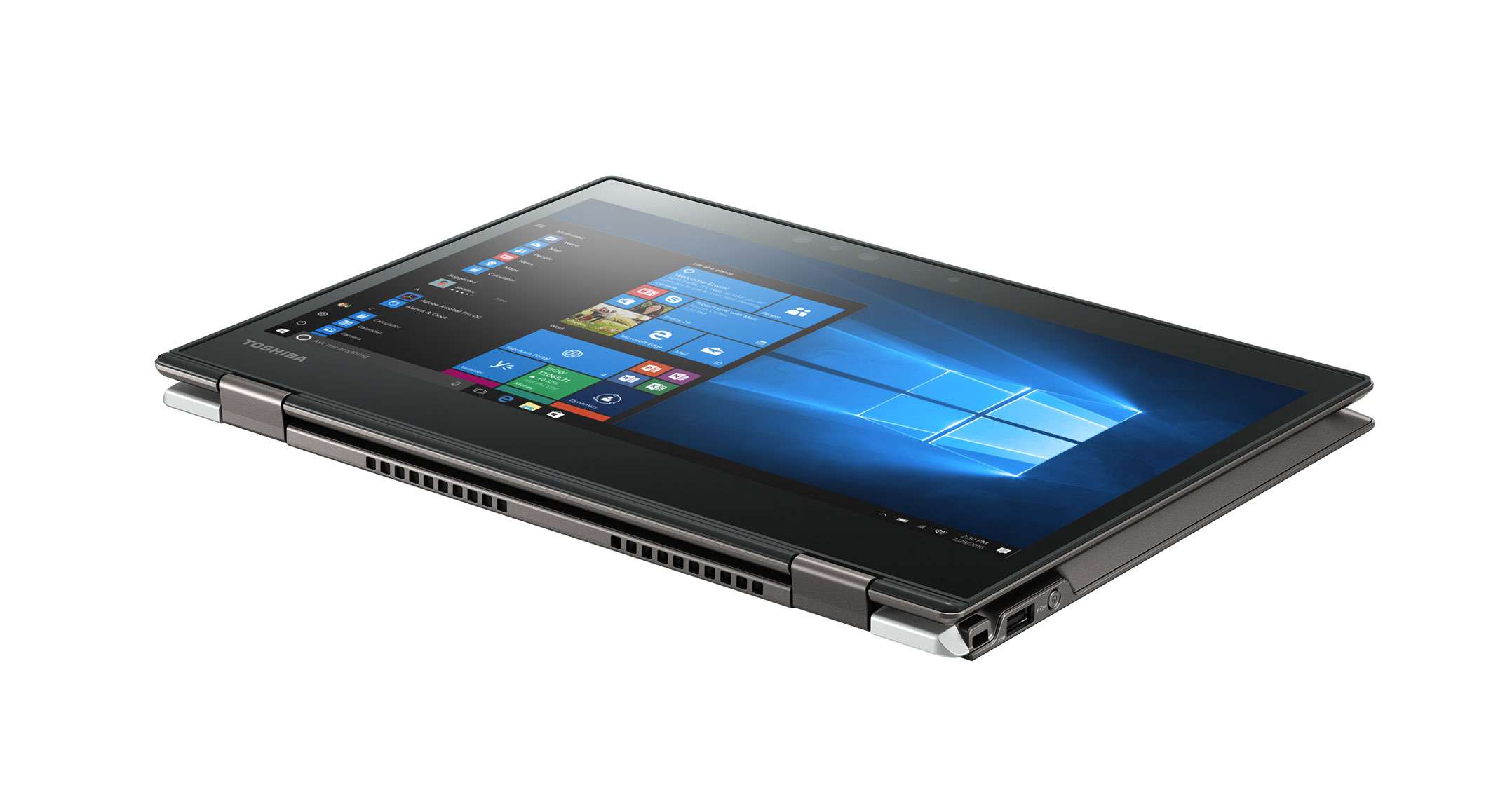
It was only a few years ago that powerful laptops were heavy, clunky things that weighed you down on your travels. Thanks to the miniaturisation of electronics, the latest high-end laptops are not only powerful, but also so lightweight you don’t need to pump iron to be strong enough to lug them around on long trips.
Toshiba’s latest ultraportable, the 1kg Portégé X20W-D, is no exception. The X20W-D is a stylish two-in-one (its touchscreen swivels 180 degrees, turning it into a Windows tablet) that’s light enough to take on the road without tipping the scales at the airport check-in.
The machine is a business powerhouse, designed for everyday office tasks — Word, PowerPoint, Outlook and perhaps even a bit of Photoshop — but, not surprisingly in this category, not for high-end gaming. On the downside, the machine, which ships with Windows 10 Pro, has only two USB ports and no SD card reader — not as bad as the new MacBook, but an extra port of two would have been useful.
Our review unit shipped with an Intel Core i5 processor (7200U) and 8GB of RAM, more than sufficient for everyday work tasks, but probably not enough for creative professionals. The machine is clearly designed for travelling businesspeople, and it’s specified sufficiently for a snappy Microsoft Office experience.
The machine’s biggest selling point is its ability, with a flick of the wrist, to go from notebook to tablet. When the screen is rotated to tablet mode, the keyboard is disabled and the touchscreen comes into its own.
The 12.5-inch widescreen full HD (1 920×1 080-pixel) display is unusually tall when held sideways in tablet mode — especially if you’re used to using an iPad or similar — but you quickly get used the format, which is great for seeing more of a website or Excel document, for example.
Of course, Windows 10 is still better as a keyboard-and-mouse-driven experience, but Microsoft has made great strides in recent years in ensuring its operating system is more touch-friendly. Bear in mind, though, that this is a laptop first, and a tablet second. If you’re in the market for a device that you intend to use primarily as a tablet, you’d probably be better off buying a tablet and pairing it with a Bluetooth keyboard.
Gorilla Glass
The screen, which is built with the Gorilla Glass 4 more commonly found in high-end smartphones, has a matte finish and antiglare coating, making it easier, with its 350-nit brightness, for reading outdoors. The touchscreen can be used either with a finger, or the bundled TruPen stylus, developed by Wacom, which offers 2 048 levels of pressure sensitivity. In out testing, the pen was highly responsive and our preferred means of using the machine in tablet mode. However, there’s nowhere to dock the pen with the notebook, so you’ll have to be careful not to misplace it!

The X20W-D’s keyboard is comfortable, but not best in class — we prefer keyboard implementations from Lenovo and Apple — but it’s also far from being the worst we’ve used. The Enter key is arguably a little on the small side, and during our testing we often found we accidentally pressed the backslash key. We’d probably get used to this over time, but we’d have preferred the Enter key to be just a tad wider. The touchpad is also a little on the small side, especially if you’ve been spoiled by Apple’s large trackpad. The fingerprint reader, which is integrated into the touchpad, works well.
It’s in the ports department where we feel Toshiba could have done more. The machine has just two USB ports — a full-sized USB 3.0 port on the right and a new-fangled USB-C/Thunderbolt 3 port on the left, with doubles as the power input. There’s an obligatory 3.5mm analogue audio/mic jack next to the USB-C port — and that’s it! If you use a lot of USB devices, you’re going to need to invest in an external hub (and who likes carrying those around?). If you’re charging the machine, you’re effectively down to just one USB port!
Our review unit shipped with a 120GB solid-state drive, though the units on sale in South Africa start at a respectable 256GB. If you use OneDrive or similar, and don’t store a lot of multimedia, that should be more than enough.
As mentioned earlier, the X20W-D is not a gaming laptop. It features basic integrated graphics in the form of the Intel HD Graphics 620, which is more than enough for watching a full-HD movie, but don’t expect to play Grand Theft Auto on the plane. The good news is that for most work, including e-mail and basic photo editing, you’re not going to tax the machine. For the most part, the computer runs very quietly, with minimal disturbance from the fan.
Despite its light weight, the X20-D’s battery is solid, delivering more than eight or nine hours of use out of a full charge — more if you turn the screen brightness right down and disconnect Wi-Fi. That’s enough juice to get a lot of work done on a flight to Europe, but you’re probably going to need to carry a charger if you plan to use it all the way on a long-haul flight to the US or Asia, for example.

The two-in-one ultraportable space has become much more competitive in recent times, with great offerings from Lenovo and others. In its class, the X20-D is relatively affordable and has a very good battery life. Build quality is also impressive.
On the downside, having just two USB ports could be a problem for some users, as could the lack of an SD card reader. But what you are sacrificing in ports, you are certainly getting back in ultraportability. — © 2017 NewsCentral Media
- The Toshiba Portégé X20W-D has a recommended retail price starting at R23 999
- Review unit provided by Mustek




